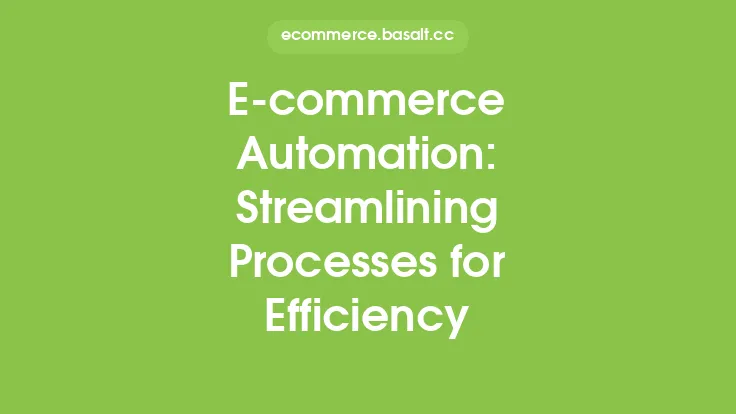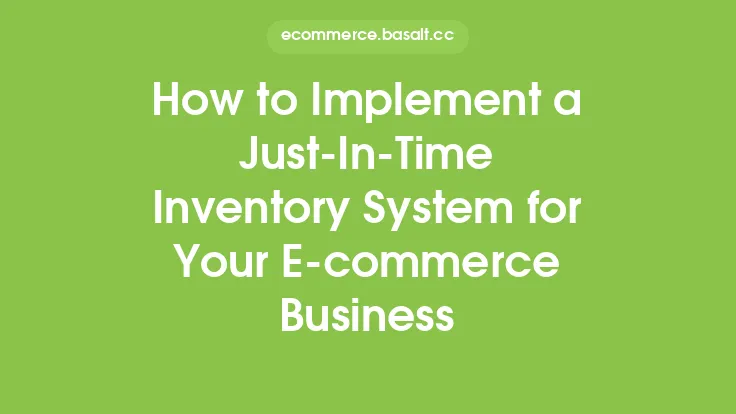In the world of e-commerce, managing inventory effectively is crucial for success. It is the backbone of any online retail operation, as it directly impacts customer satisfaction, shipping times, and ultimately, the bottom line. Streamlining inventory processes is essential to ensure that products are available when customers want them, without overstocking or understocking. This article will delve into the importance of streamlining inventory processes, the benefits it brings, and the strategies that can be employed to achieve it.
Understanding the Challenges of Inventory Management
Inventory management is a complex task that involves tracking stock levels, monitoring product demand, and ensuring that products are available to meet customer demand. However, many e-commerce businesses face challenges in managing their inventory effectively. These challenges include inaccurate inventory tracking, stockouts, overstocking, and inefficient warehouse management. Inaccurate inventory tracking can lead to stockouts or overstocking, which can result in lost sales and revenue. Stockouts occur when a product is not available to meet customer demand, while overstocking occurs when too much stock is held, leading to waste and unnecessary storage costs.
Benefits of Streamlining Inventory Processes
Streamlining inventory processes can bring numerous benefits to e-commerce businesses. One of the primary benefits is improved customer satisfaction. When products are available to meet customer demand, customers are more likely to receive their orders on time, leading to increased satisfaction and loyalty. Streamlining inventory processes can also lead to reduced costs, as businesses can avoid the costs associated with overstocking and understocking. Additionally, streamlined inventory processes can improve shipping times, as products can be quickly located and shipped to customers. This can lead to increased sales and revenue, as customers are more likely to return to a business that can deliver products quickly and efficiently.
Strategies for Streamlining Inventory Processes
There are several strategies that e-commerce businesses can employ to streamline their inventory processes. One of the most effective strategies is to implement a robust inventory management system. This system should be able to track stock levels in real-time, monitor product demand, and provide alerts when stock levels are low. Another strategy is to use data analytics to forecast demand and optimize inventory levels. By analyzing historical sales data and seasonal trends, businesses can predict demand and adjust their inventory levels accordingly. Additionally, businesses can implement a just-in-time inventory system, where products are ordered and received just in time to meet customer demand. This can help to reduce waste and minimize storage costs.
Best Practices for Inventory Management
There are several best practices that e-commerce businesses can follow to streamline their inventory processes. One of the most important best practices is to conduct regular inventory audits. This involves physically counting stock levels to ensure that they match the levels recorded in the inventory management system. Another best practice is to use barcode scanning and RFID technology to track stock levels and monitor product movement. This can help to improve the accuracy of inventory tracking and reduce the time spent on inventory management tasks. Additionally, businesses can implement a first-in, first-out (FIFO) inventory system, where the oldest products are sold or shipped first. This can help to reduce waste and minimize the risk of obsolete inventory.
Technology and Automation in Inventory Management
Technology and automation play a crucial role in streamlining inventory processes. Inventory management software can help to automate many inventory management tasks, such as tracking stock levels, monitoring product demand, and providing alerts when stock levels are low. Additionally, automation technologies such as robotics and machine learning can be used to improve the efficiency of warehouse operations and reduce the risk of errors. For example, robotics can be used to automate tasks such as picking and packing, while machine learning can be used to predict demand and optimize inventory levels. By leveraging technology and automation, e-commerce businesses can streamline their inventory processes, improve customer satisfaction, and increase sales and revenue.
Conclusion
Streamlining inventory processes is essential for e-commerce success. By understanding the challenges of inventory management, implementing effective strategies, and following best practices, businesses can improve customer satisfaction, reduce costs, and increase sales and revenue. Technology and automation play a crucial role in streamlining inventory processes, and businesses should leverage these tools to improve the efficiency of their inventory management operations. By streamlining inventory processes, e-commerce businesses can stay competitive in a rapidly changing market and achieve long-term success.




